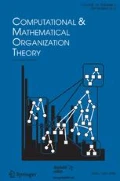Abstract
This paper examines social groupings whose structure depends only on the distribution of ability to attract attention. When people‘s attention is a scarce resource, those individuals who are rated highest by a large number of other individuals will have to ration their attention, resulting in constraints on the social structure of the group. The incidence of popular individuals by that definition reflects the extent to which individuals agree on who their highest-rated colleague is. We propose three basic distributions or ways to generate the matrix of perceived ability so as to yield popularity profiles that can be parametrically adjusted to match observations. We demonstrate that each of these assumption sets leads to a slightly different correlation between the value of the assumption‘s parameter and the set of observable popularity patterns. Since popularity, in real life, often determines such things as power, centrality, over-utilization and perhaps reduced accessibility, having more realistic ways of representing it is important for modeling and understanding virtual organizations and communities.
Similar content being viewed by others
References
Banks, D. L., and K. M. Carley. 1996. Models for network evolution. Journal of Mathematical Sociology21(1-2):173-196.
Brass, D. J., and M. E. Burkhardt. 1992. Centrality and power in organizations. In N. Nohria and R. G. Eccles (Eds.), Networks and Organizations: Structure, Form and Action. Boston, MA: Harvard Business School Press.
Burt, R. S. 1992. Structural Holes: The Social Structure of Competition. Cambridge, MA: Harvard University Press.
Carley, K. M. 1990. Group stability: A socio-cognitive approach. Advances in Group Processes7:1-44.
Carley, K. M. 1991. A theory of group stability. American Sociological Review56:331-354.
DiMaggio, P. 1992. Nadel’s paradox revisited: Relational and cultural aspects of organizational structure. In N. Nohria and R. G. Eccles (Eds.), Networks and Organizations: Structure, Form and Action. Boston, MA: Harvard Business School Press.
Feller, W. 1968. An Introduction to Probability Theory and its Applications. Chichester, New York: John Wiley and sons.
Freeman, L. C. 1997. Uncovering organizational hierarchies. Computational and Mathematical Organization Theory3(1).
Huberman, B. A., and T. Hogg. 1995. Communities of practice. Computational and Mathematical Organization Theory1(1).
Kaufer, D. S., and K. M. Carley. 1993. Communication at a Distance: the Influence of Print on Sociocutural Organization and Change. Hillsdale, NJ: Lawrence Erlbaum Associates.
Scott, J. 1991. Social Network Analysis: A Handbook. London: Sage Pubications.
Author information
Authors and Affiliations
Rights and permissions
About this article
Cite this article
Nasrallah, W., Glynn, P. & Levitt, R. Diversity and Popularity in Organizations and Communities. Computational & Mathematical Organization Theory 4, 347–372 (1998). https://doi.org/10.1023/A:1009686430066
Issue Date:
DOI: https://doi.org/10.1023/A:1009686430066




